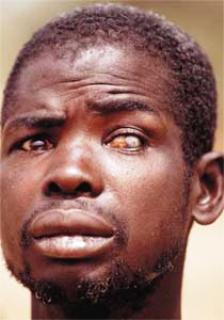S. Sudan: Over 5 million at risk of river blindness
July 20, 2013 (JUBA) – Nearly six million South Sudanese remain at risk of contracting river blindness disease due to negligence, health officials have warned.

Its symptoms, among other include intense itching, skin rash and discoloration, eye lesions, and/or subcutaneous bumps (nodules) under the skin. The skin becomes depigmented after the lesions heal.
Grace Fobi, the director of Africa Programme for Onchocerciasis Control (APOC), said river blindness ranks among the worst tropical disease on the African continent.
She made the remarks during this week’s re-launch of Ochocerciasis Control Program in Juba, South Sudan.
Fobi said South Sudan needs to urgently improve its managerial and technical capabilities for the control program to effectively realize its aims.
The re-launch of the program, health officials told Sudan Tribune, follows results of the 2011 sustainability evaluation APOC conducted in the two-year old country.
According to Dr. Fobi, the APOC spring board recommended that a roadmap be developed and presented to all partners for a re-launch of a community-directed treatment for river blindness and other tropical infections in the country.
LONG-TERM GOAL
APOC, she said, will fully support South Sudan in its campaign against river blindness and all other tropical diseases in the region.
“We have adopted a long-term goal to eliminate the Onchocerciasis infection and interrupt its transmission 80% by 2025 in South Sudan,” Dr. Fobi said, but stressed that achieving this goal requires proper coordination between government and its partners.
Meanwhile, South Sudan’s Health minister, Dr. Milly Hussein did acknowledged that the country was at risk, with children aged between 5-10 years most affected.
The minister cited Western Equatoria and Eastern Equatoria states that lie in the tropical zone, as the worst affected regions.
On his part, the country’s health minister, Milly Hussein confirmed that the region at large is at risk with children 5-10 years old already infected particularly in Western Equatoria State, Eastern Equatoria and other tates lies on tropical line.
Hussein, however, expressed concerns that the disease may not completely be eradicated, due financial and technical shortfalls in the country.
He further stressed that only a joint commitment between government and its health partners would the Onchocerciasis Control Program realise the aim for which it was launched.
WORRYING STATISTICS
An estimated 17.7 million worldwide, according to the World Health Organization (WHO), are affected by river blindness.
Of this number, about 270,000 are reportedly blind and another 500,000 have visual impairment.
WHO says about 99% of infected persons reportedly live in Africa, with the remainder in Yemen, Mexico, Guatemala, Ecuador, Colombia, Venezuela and Brazil.
(ST).
